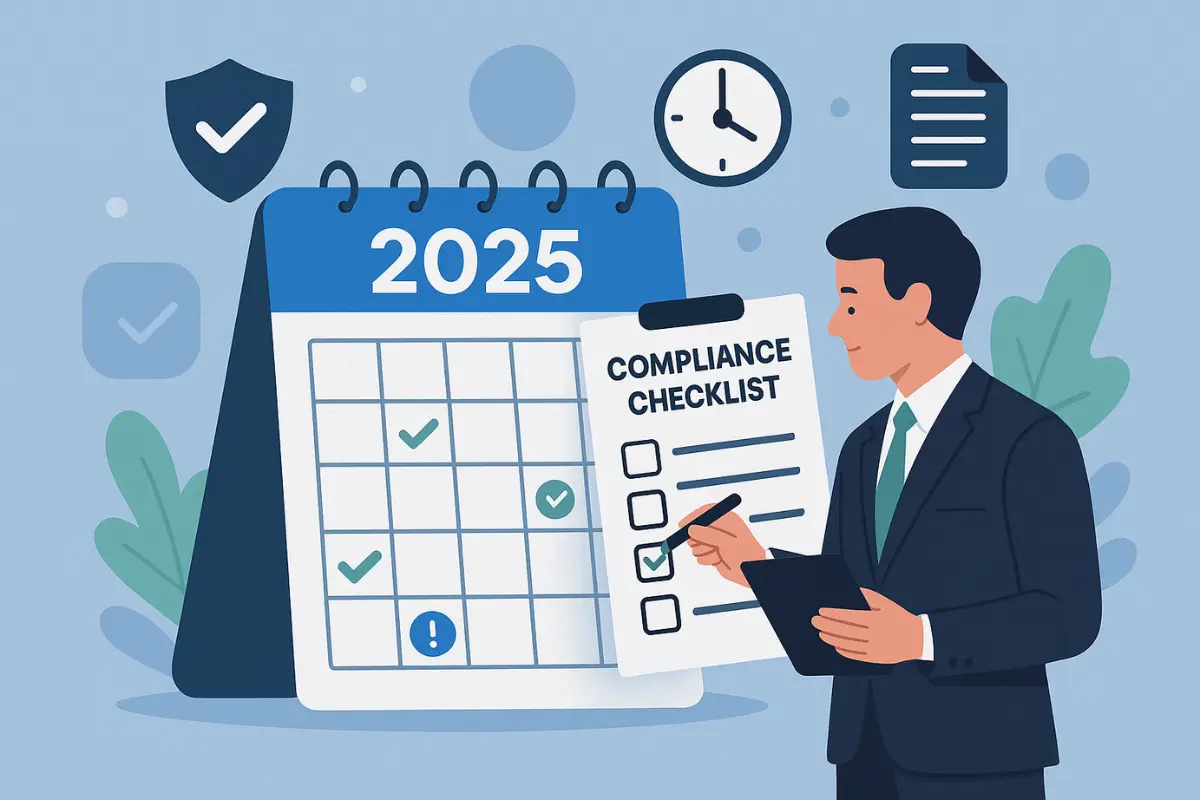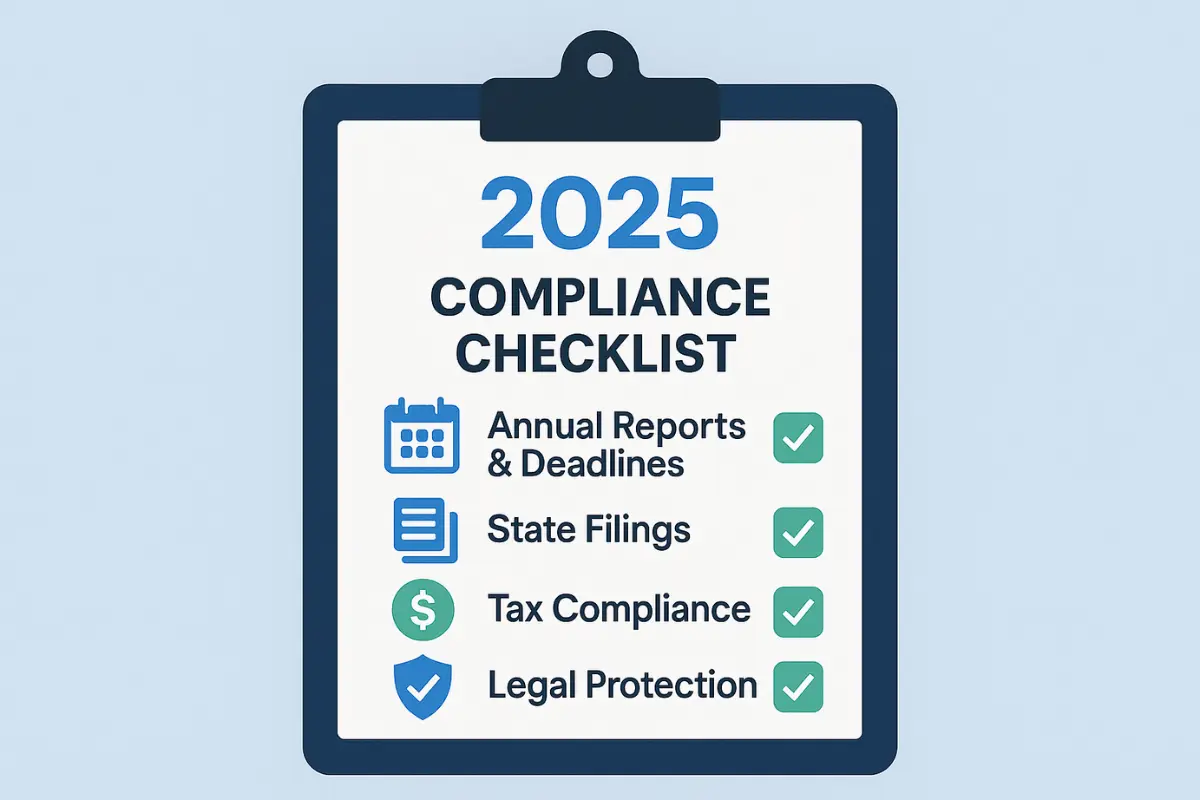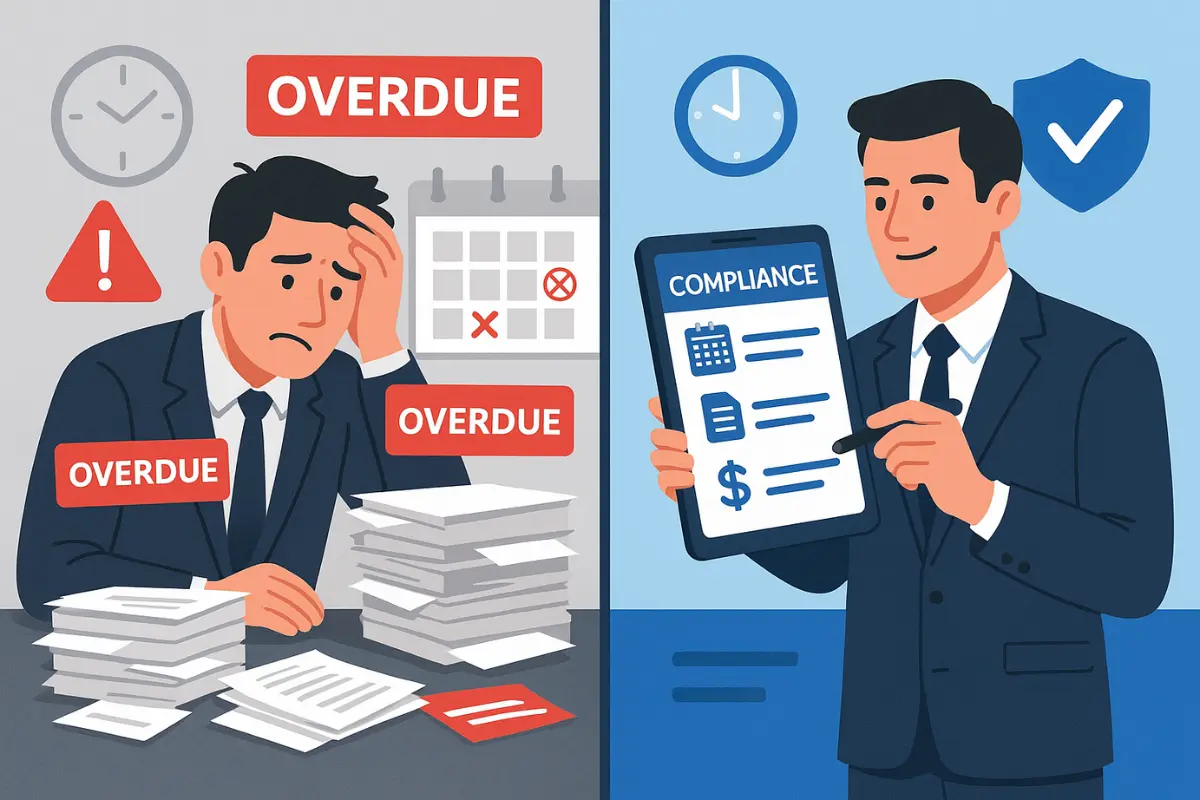Annual Compliance Checklist for 2025

What if a single missed filing deadline or an overlooked policy update triggered a chain reaction of fines, legal disputes, and reputational damage that could have been prevented with a one-hour review? This isn't a scare tactic; it's the reality for businesses that treat compliance as an afterthought. Annual compliance isn't about bureaucracy; it's the strategic discipline of proactively aligning your business with the legal and regulatory landscape to protect it from avoidable risk.
The rules of the game change every year bringing new data privacy considerations, evolving ESG reporting standards, and updates to employment law. This 2025 corporate compliance guide provides a clear, actionable checklist of the core essentials you must review to ensure your business doesn't just survive the coming year, but thrives with confidence.

Key Takeaways
-
Proactivity is Protection: An annual compliance review is your primary defense against penalties, lawsuits, and operational disruptions.
-
Scope Beyond Finance: Compliance in 2025 encompasses data privacy, ESG, HR policies, and industry-specific rules, not just taxes and filings.
-
Documentation is Evidence: Meticulous records of meetings, policy updates, and decisions are your proof of good faith efforts to comply.
-
Internal Alignment is Critical: Compliance is a team effort; clear communication and assigned responsibilities across departments are essential.
-
Leverage Expertise: Compliance professionals bring specialized knowledge and systematic processes that can significantly reduce oversight risks and administrative burden.
Why an Annual Compliance Checklist Matters in 2025
Viewing your 2025 business compliance checklist as a mere administrative task is a critical error. A well-designed compliance checklist is a valuable tool for navigating the increasing complexity of the regulatory environment, helping your business systematically address key annual compliance requirements and building a more resilient, trustworthy operation. A comprehensive checklist significantly reduces the risk of costly oversights and creates the foundation for ongoing regulatory management.
Managing and Evaluating Regulatory Changes
Laws are not static. New legislation at the state and federal levels, along with evolving judicial interpretations, creates a constantly changing regulatory landscape for businesses. While regulatory updates occur throughout the year, a dedicated annual review helps ensure you systematically evaluate and integrate these changes into your compliance framework, rather than operating with outdated policies and procedures.
Avoiding Legal and Financial Penalties
The consequences of non-compliance extend far beyond simple oversight. Fines for missed filings, late tax payments, or workplace safety violations can severely impact your bottom line and drain resources that should fuel growth. This is precisely why businesses implement structured compliance audits as a preventive measure rather than waiting for problems to emerge.
As Roman Burdiuzha of Gart Solutions explains, "Compliance audits are an essential tool for managing legal and operational risks. By conducting regular audits, identifying compliance gaps, and implementing corrective actions, companies can maintain a robust compliance framework that protects against regulatory penalties and legal liabilities."
External audits serve an important verification function, confirming your adherence to industry standards and regulations while identifying areas of nonconformance before they escalate into costly penalties. The investment in systematic compliance audits consistently proves less expensive than addressing violations after they occur.
Protecting Business Reputation
Your reputation is one of your most valuable assets. Timely and accurate disclosure of required information is essential for maintaining trust and regulatory compliance. A single compliance failure—a data breach from outdated security protocols, a labor violation, or failing to comply with privacy laws such as GDPR and CCPA can severely damage your reputation with customers, partners, and investors. Consistent compliance demonstrates integrity and operational excellence.
Streamlining Internal Processes
Chaos is costly. By implementing a clear regulatory compliance checklist, your team gains direction and accountability for managing critical responsibilities. This organized approach not only minimizes confusion and stress, but also frees up time and energy to focus on growing your business instead of navigating governance hurdles.
Enhancing Business Value and Preparing for Investment
Investors and potential buyers conduct thorough compliance due diligence, which includes evaluating your track record with regulatory agencies. A strong history of compliance not only increases your business’s value but also makes it more attractive, fundable, and saleable. It demonstrates that your company has a stable foundation for sustainable, long-term growth.
To support this growth, it’s essential to invest in robust compliance systems and training programs focused on critical areas such as workplace safety, diversity, and cybersecurity. These investments not only reduce risk but also strengthen your company’s reputation and readiness for investment opportunities.
Core Annual Compliance Essentials for 2025 (Checklist)
This regulatory compliance checklist is designed to be comprehensive yet adaptable. Use it as a master framework and ensure it is tailored to your industry and specific business needs. Following this checklist will help ensure compliance with all relevant regulations and legal compliance essentials.

Corporate Governance and Documentation
-
Annual Report Filing: Confirm the deadline with your Secretary of State and file your annual report. Note that in some states, the deadline is based on the anniversary of the entity’s formation. This is mandatory for maintaining good standing.
-
Review Corporate Minutes: Document annual shareholder and director meetings. Update records for major decisions like loans, acquisitions, or changes in ownership. Also, ensure that any changes in business activities, such as adding locations, mergers, or introducing new products, are properly documented, as these may impact compliance obligations.
-
Governing Document Audit: Review your LLC Operating Agreement, Corporate Bylaws, and articles of incorporation or similar foundational articles. Ensure they reflect current ownership percentages, management structures, and operational procedures.
-
Registered Agent Verification: Confirm your registered agent is still accurate, active, and properly listed with the state.
Regulatory and Financial Compliance
-
Tax Filings and Deadlines: Mark calendars for federal, state, and local tax deadlines (income, sales, payroll). Plan for 1099-NEC filings for contractors by January 31.
-
Financial Statement Review: Ensure your bookkeeping is up-to-date and accurate. Consider a review or audit by a third-party accountant to confirm compliance with accounting standards and regulations.
-
Business License Renewals: Identify all business licenses and industry-specific permits. Track their renewal dates and submit renewals timely to maintain compliance.
Employment and Labor Compliance
-
Employee Handbook Review: Update policies to reflect current federal, state, and local laws on leave, remote work, anti-harassment, anti-discrimination, and overtime. Ensure compliance with the FLSA for minimum wage, overtime pay, and employee classification requirements.
-
Employment Contracts Review: Review employment contracts to ensure they meet current legal standards, clearly define rights and obligations, and comply with regulatory requirements.
-
Poster Compliance: Mandatory workplace posters (e.g., OSHA, FMLA, EEOC) are updated frequently. Ensure yours are the current versions.
-
I-9 Form Audit: Conduct a voluntary internal audit of I-9 forms to ensure proper completion and storage, correcting errors before a government audit.
-
Payroll Compliance: Verify that your payroll system is correctly calculating wages, taxes, and benefits under current law.
Data Privacy and Cybersecurity Requirements
-
Privacy Policy Update: Review and update your website privacy policy and internal data handling procedures to align with new state laws (e.g., California’s CPRA, Colorado’s CPA). Emphasize the importance of protecting sensitive data under regulations like GDPR and CCPA. Departments should collaborate to ensure effective data governance and incident response.
-
Cybersecurity Assessment: Conduct a basic risk assessment. Check for software patches, review access controls, and ensure data is backed up. Be aware that data breaches can result in loss of customer trust, regulatory penalties, and financial harm. Follow data security best practices as outlined by the National Institute of Standards and Technology (NIST). These steps help maintain a safe environment for your data.
-
Incident Response Plan: Establish a clear, written plan that outlines how to respond promptly and effectively to data breaches. This plan must include notification procedures consistent with legal requirements. According to the HIPAA Breach Notification Rule, “Organizations must notify individuals affected by a breach within 60 days of its discovery,” and notifications should detail the breach, types of data involved, steps individuals should take, actions taken to contain the breach, and how further inquiries can be made. Reference the Accountability Act and HIPAA as guiding frameworks to ensure comprehensive privacy protections and data security in healthcare.
Industry-Specific Regulations
-
Identify Key Regulations: Whether you’re in healthcare (HIPAA), finance (SEC), or construction (OSHA), dedicate time to reviewing the specific regulatory compliance checklist that applies to your operations in 2025. Regulations may vary by region, so ensure you review and comply with the legal and regulatory frameworks relevant to your geographic area.
-
Certification and Training: Confirm that all required professional certifications for you and your team are current and that mandatory annual training has been completed.
Global Compliance Considerations
If your business serves international customers or works with overseas partners—even as a small or mid-sized company—compliance obligations extend beyond U.S. borders. Navigating international rules requires attention and planning.
Core areas include:
-
Data Privacy: Laws like the EU’s GDPR and California’s CCPA impact any U.S. business that collects data from foreign or out-of-state customers. Even modest companies must use clear privacy policies and obtain consent when handling customer information—non-compliance can bring significant fines.
-
Healthcare Compliance: If your business processes electronic health data or partners with overseas healthcare organizations, you'll need to understand international standards for patient privacy and safety.
-
Financial Regulations: Selling products or services internationally brings new tax rules, reporting requirements, and transparency expectations. Accurate financial and tax reporting is essential for small businesses, too, to avoid disruption and penalties.
For many small and mid-size businesses, global compliance can be managed by a designated point person or trusted external advisor. The key is to establish clear processes, keep up with changing rules, and regularly review your practices, especially as your business grows or your international footprint expands.
This approach helps protect your business, strengthens trust with global customers, and supports sustainable growth in today’s interconnected economy.
Integrating Compliance Audits into Business Operations
A proactive audit strategy is the best way to identify hidden compliance issues before they escalate into penalties or legal action. Internal audits should be a regular part of your company’s compliance process.
This means routinely reviewing:
-
HR & Legal: Confirm your policies and practices meet current labor laws, wage requirements, and workplace safety standards.
-
Finance: Look for errors or signs of fraud, and make sure reporting is accurate.
-
Overall Governance: Check that daily tasks and company-wide standards are consistently followed.
The goal of these internal audits is not to blame anyone but to uncover gaps. They provide the objective evidence needed to strengthen controls, improve processes, and demonstrate your company's commitment to ethical practices and full compliance. This integrated approach turns your audit function from a simple regulatory compliance checklist into a powerful tool for operational excellence and risk management.
Compliance Remediation: Addressing Gaps and Failures
No matter how diligent your business is, compliance gaps or failures can still happen. That's just part of operating in a complex regulatory environment. Compliance remediation is the structured process of tackling these issues head-on. Whether it means updating outdated policies, providing targeted employee training, or putting new controls in place, remediation is about fixing what’s broken and preventing the same problems from happening again.
Taking a proactive approach to remediation is essential. It helps minimize risks like costly fines, lawsuits, or damage to your company’s reputation. For example, healthcare organizations must carefully manage their obligations under HIPAA to avoid heavy penalties and protect employee rights. But whatever industry you’re in, quickly identifying and correcting compliance failures shows your commitment to your workforce, customers, and partners.
Empowering Your Team Through Training and Technology
Mitigating compliance risks requires more than a written policy. Success starts with an informed team and the right technological support. Human resources play a central role by safeguarding employee rights and ensuring every team member knows their role in maintaining regulatory compliance. Here are proven strategies for building a resilient compliance culture:
Pair continuous education with strategic tools for best results:
-
Continuous Education: Schedule regular training sessions to keep your staff up to date on new risks and changing compliance requirements. This fosters a proactive mindset and empowers employees to be the first line of defense.
-
Strategic Tools: Use specialized software to automate routine tasks, like tracking state filing deadlines and managing documents. The right platform reduces human error, and frees up your team to focus on complex compliance matters.
This combined approach is non-negotiable in high-stakes areas. Adherence to regulations like the Sarbanes-Oxley Act for financial governance and stringent anti-money laundering protocols demands precision. Regular audits of these processes are crucial to ensure complete regulatory compliance and avoid the severe penalties associated with non-compliance.
Ultimately, investing in your team’s knowledge and tools doesn’t just prevent violations, it builds a culture of accountability where regulatory compliance is a shared and manageable responsibility. As regulations evolve, organizations must continue to expand compliance training and technology initiatives to meet increasing expectations.
Measuring Success: Compliance Metrics and KPIs
To ensure your compliance program is truly effective, it’s important to track performance using clear metrics and key performance indicators (KPIs). Monitoring data such as training completion rates, audit results, incident response times, and policy update implementation gives valuable, actionable insight into your organization’s strengths and areas for improvement.
Investing in compliance management software can help automate the collection and analysis of these metrics, simplifying the process across all your business units or subsidiaries.
For example:
-
Employee Training Completion Rate: Confirms your teams stay current on regulatory requirements.
-
Audit Finding Resolution Time: Highlights how effectively compliance issues are addressed.
-
Number of Compliance Incidents: Tracks violations, helping you spot trends and target areas needing attention.
-
Policy Update Implementation Rate: Measures how quickly new or revised policies are rolled out and adopted.
Leveraging these KPIs allows your organization to make informed decisions, allocate resources where they’re needed most, and continuously refine your compliance program for maximum impact. Robust compliance metrics don’t just keep you in line—they build a culture of accountability, transparency, and ongoing improvement
Driving Excellence: Compliance Continuous Improvement
Compliance isn’t a one-time milestone—it’s an ongoing process of continual enhancement. By regularly reviewing and updating compliance procedures, your organization can be prepared for regulatory changes, address new laws, and adopt industry best practices. Continuous improvement means examining what worked, learning from past missteps, engaging with regulatory bodies, and implementing proven control mechanisms to minimize future risks.
Staying current with compliance technologies and monitoring industry updates helps your organization adapt quickly and maintain good standing, even as standards evolve. Commitment to continuous improvement builds a resilient compliance framework that not only meets today’s requirements, but is agile enough to anticipate and address emerging challenges.
Common Mistakes Businesses Make with Annual Compliance
“Compliance functions may seem like a business expense, but the costs of non-compliance—such as failed deals or financing, severed partnerships and costly penalties—far exceed the investment in compliance. As a tax professional, I advise companies on the risks of non-compliance and suggest they view compliance as a safeguard and driver for improvement that can enhance efficiency and planning, streamline processes, unlock cost savings and drive growth.” — Brent Lessey, Forbes Finance Council.

Overlooking Regulatory Updates
Assuming "last year's rules still apply" is a recipe for penalties. Regulations can change at any time, and legal requirements often evolve in response to new laws, policies, or enforcement priorities. A rule that was a recommendation in 2024 might be a mandate in 2025. Regularly monitoring regulatory updates and reviewing compliance practices ensures your business remains protected and up-to-date.
Missing Critical Filing Deadlines
Calendar management is a core compliance skill. Missing a state annual report deadline by one day can trigger late fees and eventually loss of good standing.
Incomplete or Poor Documentation
If it wasn't documented, it didn't happen. In the eyes of regulators and courts, missing meeting minutes or unsigned policy updates are seen as evidence of non-compliance.
Ignoring Industry-Specific Requirements
A general checklist is a start, but it's not enough. A healthcare provider has vastly different obligations than a retail store. Failing to address your niche requirements leaves you exposed.
Neglecting Data Privacy and Security Obligations
Treating cybersecurity as an IT issue instead of a core compliance responsibility is a critical mistake. A data breach is both a technical and a legal failure.
Failing to Communicate Compliance Responsibilities Internally
When everyone is responsible, no one is responsible. Clear ownership of each task on the regulatory compliance checklist is essential for execution.
Treating Compliance as a One-Time Task
Compliance is a continuous process. The annual checklist is the cornerstone, but it requires quarterly check-ins to stay on track and adapt to mid-year changes.
FAQs
How often should a business review its compliance policies?
A comprehensive annual review is essential to keep compliance policies current and aligned with regulatory requirements. Best practice also includes scheduling brief quarterly check-ins throughout the year. These frequent reviews help you monitor for regulatory updates and operational changes, allowing you to make timely adjustments before small issues become serious problems. This dual approach ensures your business remains agile, compliant, and prepared for whatever comes next.
Who in a company should be responsible for managing compliance?
Ultimately, business owners or senior leaders are accountable for compliance. However, effective execution means sharing the responsibility. For small and mid-sized companies—with or without subsidiaries—it's best to designate a primary compliance lead (such as a COO, CFO, office manager, or compliance officer) to coordinate the checklist and track deadlines. At the same time, involve managers from core areas like HR, Finance, and IT—both at headquarters and in each location or subsidiary—to make sure nothing falls through the cracks.
What is the difference between compliance and risk management?
Compliance means following current laws, regulations, and standards—a definitive set of requirements. Risk management is a broader, proactive process: it identifies and evaluates potential risks to the business (including regulatory and operational threats) and develops strategies to mitigate them. Compliance is one element of an effective risk management program, ensuring legal adherence while risk management covers all possible threats to business success.
Can small businesses use the same compliance checklist as large corporations?
The core compliance principles are the same for both small businesses and large corporations. What changes is the level of detail and resources needed. A small business may not need a formal ESG report, but it absolutely must file its annual report, manage payroll taxes, and maintain an up-to-date data privacy policy. Use this checklist as a flexible framework and scale and customize it to fit your company’s size, risk level, and industry requirements.
Take Charge of Your 2025 Compliance Today!
While compliance covers a wide range of requirements—from tax filings to advanced reporting—the foundation is built on a few essentials every business must manage: proper entity formation, registered agent service, annual state reports, and timely responses to government notices.
InCorp specializes in helping businesses lay a strong compliance foundation.
Our services include:
-
Reliable registered agent service in every state
-
Expert formation and incorporation filings
-
Timely annual report and managed filings
-
Automated compliance reminders and monitoring tools
By trusting InCorp with these key compliance tasks, you protect your company’s status, avoid costly penalties, and create peace of mind knowing your business is built on a solid foundation.
Get Started with Foundational Compliance Solutions from InCorp
Share This Article:
Stay in the know!
Join our newsletter for special offers.